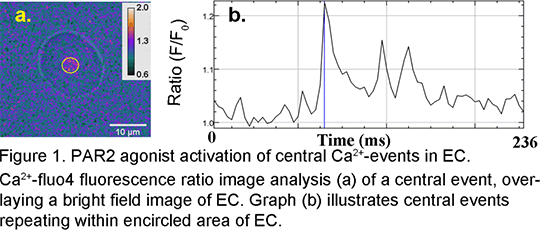Activation of central Ca2+-release events by a PAR2-agonist in mouse endothelial cells Introduction: Protease activated receptor-2 (PAR2) agonist 2-furoyl-LIGRLO activates two types of local calcium (Ca2+)-release in endothelial cells (ECs): peripheral events are located near the plasma membrane while central events are located at the centre (1). ECs Ca2+-release stimulates synthesis of nitric oxide (NO·) and hyperpolarization of vascular smooth muscle (vsm), which dilate arteries. PAR2-mediated Ca2+-release and vasodilation are unique, relative to those of other cell surface receptors, in being protected against endothelial dysfunction (1, 2). PAR2 signaling can vary depending on cell-type, subcellular locations, and agonist biased signaling by different classes of PAR2 drugs. Agonist bias refers to the property of individual PAR2 agonists to activate selectively subsets of signaling pathways while excluding others. Here we examined the Ca2+-release events elicited by another PAR2 agonist, tcLI (transcinnamoyl-LIGRLO), in ECs. Methods: ECs were prepared from murine (C57B6) mesenteric arterial branches and loaded with Ca2+-sensitive dye Fluo4-AM as described (1). ECs were superfused with HEPES-buffered Krebs solution pH 7.4 at 25 °C and then exposed to PAR2 agonist tcLI (10 µM). The effect of tcLI on intracellular Ca2 was regionally assessed in single cells by 2D-spinning disk confocal microscopy and video imaging of Fluo4 fluorescence (F) as described (1). Results: We found tcLI elicited repeating Ca2+-events in the central region of EC (Figure 1) whereas Ca2+ events were not elicited in the peripheral region under the same conditions. tcLI increased the relative frequency of central Ca2+ events by up to 27-fold relative to the baseline untreated cell preparation.
Conclusion: Compared to previous results, we found that another PAR2 agonist activates central Ca2+ release only, supporting the notion of PAR2 agonist biased Ca2+-release in ECs and warrant further study of different classes of PAR2 agonists. (1) Hennessey JC et al. (2015) Pharmacol Res Perspectives 3: e00112. (2) McGuire JJ et al. (2011) BMC Pharmacol 11:10.
|


